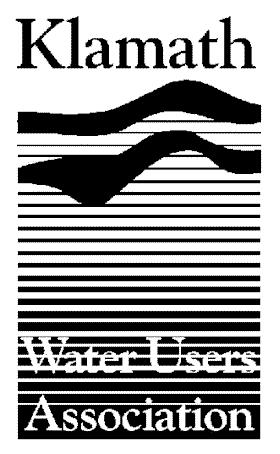
Klamath Water Users Association
Letter to the Oregonian by
KWUA
Executive Director Dan Keppen
May 2, 2004
|
|
Klamath Water Users Association Letter to the Oregonian by
KWUA May 2, 2004
|
| May 2, 2004 The
Oregonian Dear Editor: Michael Milstein’s article in the May 2, 2004 edition of the Sunday Oregonian ("Klamath Wells Deep in Trouble") provides a balanced and empathetic treatment of the efforts undertaken by Klamath Project irrigators to address their water supply challenges. Hopefully, readers of this article will come away with an appreciation for the sense of determination and frustration faced by local producers as they try to plan for a future that is controlled by regulatory uncertainty. Importantly, Mr. Milstein’s article partially addresses the true and primary reason that is driving the challenges faced by the Klamath Project and the national wildlife refuges: that is, fishery agency regulations that promote high lake levels and river flows. The article does not note that these artificially high levels – such as those that contributed to the 2001 curtailment of Upper Klamath Lake irrigation supplies - have been questioned by the National Academy of Sciences. In the past 40 to 50 years, while the cropping pattern in the Klamath Project has varied from year to year, the overall planted acreage has remained consistent. On the other hand, the 2002-2012 biological opinion created by NOAA Fisheries for coho salmon established the river flow schedule and the water bank – which ratchets up to 100,000 acre-feet in 2005, regardless of actual hydrologic conditions – that is the primary source of new demand for water in the Klamath River watershed. The result: stored water that has flowed to farms, ranches and the refuges for nearly 100 years is now sent downstream at such high levels, that groundwater pumped from the Lost River basin is being used to supplement the resulting "coho salmon demand" in the Klamath River. It is not the farmers who have imposed new water demands that, in essence, have made groundwater the default supplemental supply to the Klamath Project. It is the opinions of agency fishery biologists who have fundamentally altered how our century-old water project operates, and who have apparently failed to anticipate the resulting impacts to our community. Sincerely, Following is an additional response by Keppen: Some other concerns not addressed in that letter:
The article made no mention of the VOLUNTARY efforts taken by irrigators
last summer (and the previous fall) to pump groundwater or alter
management practices to keep more water in the system to meet biological
opinion and tribal trust requirements. On the Oregon side, over 11,000 AF
of groundwater was pumped - with no compensation - to avoid a "bust" of
Upper Klamath Lake levels last July. In California, Tulelake Irrigation
District pumped another estimated 17,000 acre feet last summer towards
this end without any federal compensation.
We were somewhat disappointed that no mention was made of our (KWUA)
efforts to develop a water bank in 2002-03, which was rejected by USBR.
We spent considerable time addressing the groundwater issue during the
preparation of our proposal.
We believe the coho biological opinion's rigid water bank schedule,
which steps up the magnitude of the bank for the first four years,
regardless of actual hydrology, is difficult to justify. This type of
water bank does not reflect the intent of either the KWUA proposal, or
the original USBR biological assessment, which proposed implementation
of a water bank in drier years, not every year.
Finally, one key dynamic not fully explained in the article is that,
unfortunately, the cash flow stream provided by the current water bank
is starting to look like more of a sure bet to some local irrigators
than the uncertain alternative; that is, harvest of crops dependant upon
a reliable, season-long Klamath Project water supply. Last year's
near-crisis - where the government at one point had decided to curtail
Project deliveries in the middle of the summer to avoid dropping Upper
Klamath Lake 0.1 ft below the sucker fish biological opinion requirement
- did not help local irrigators' confidence level.
|
|
Klamath Water Users
Association |
Content and Logo: Copyright © Klamath
Water Users Association, 2002 All Rights
Reserved
Page design: Copyright ©
klamathbasincrisis.org, 2002, All Rights
Reserved